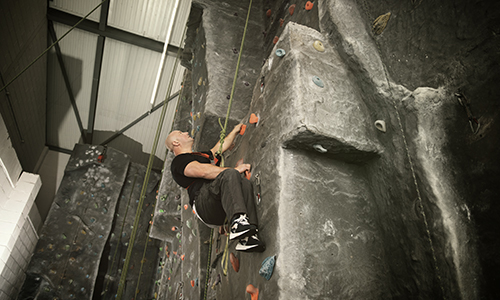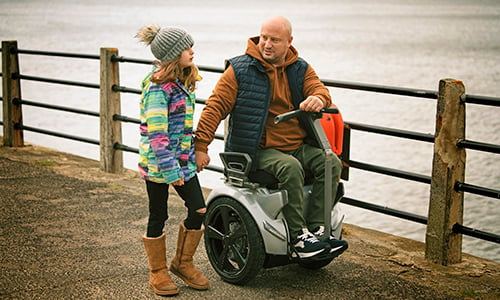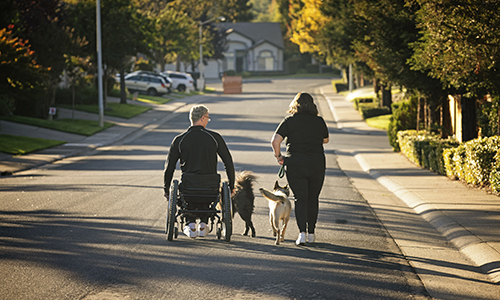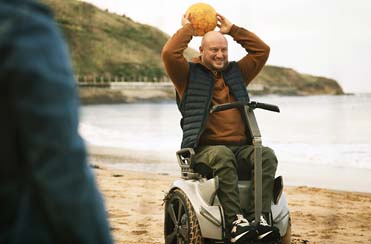Wellbeing leader, award-winning author and co-founder of Breathworks Vidyamala Burch OBE spoke to us about wellness and meditation for spinal cord injuries to help manage pain using her mindfulness-based approach. This has helped over 100,000 people worldwide and has grown from her experience of living with a spinal injury.

Vidyamala sustained several spinal injuries in her teenage years and early twenties that required multiple surgeries and left her with incomplete paraplegia and chronic pain. Her life changed when she meditated for the first time in hospital and realised that she had more choice than she thought in how she experienced her pain.
She started teaching mindfulness and meditation to others who live with pain, illness and difficulty and developed the world’s first Mindfulness-based Pain & Illness Management (MBPM) approach, substantiated by a body of evidence-based research showing the efficacy of its programmes.
Vidyamala is now recognised as one of the most influential disabled people in the UK, is an honorary member of the British Pain Society, a policy advisor with the Mindfulness Initiative, and this year was awarded an OBE for her services to pain management and wellbeing. Her mission through her work is to pass on the simple yet transformative tools that have helped her to live a more prosperous, fuller and more meaningful life.
Here are her 6 ways a mindfulness-based approach can help those with spinal injuries.
Distinguish between Primary and Secondary Suffering
Pain can be an overwhelming experience that, over time, can start to weigh you down. Mindfulness techniques can help lighten the load by changing how pain is experienced through training the mind to respond differently.
The way that we experience pain is made up of two elements: our primary and secondary suffering.
Our primary suffering is the direct, felt experience of pain in the moment.
Our secondary suffering is the negative thoughts and judgements we add on top in reaction to pain.
As the thoughts, emotions and worries build, we add layers of additional suffering that contribute to our physical tension and felt pain – creating a snowball effect that worsens over time. Through awareness, we can learn to accept any primary pain in each moment with quiet grace and let go of the secondary reactive suffering.
This helps cut through spirals of negative thinking before we are dragged in. We can choose to take care of what we really need at that moment, like breathing a little deeper and slower or relaxing the mind.
The following video from Breathworks explains how this works in a little more detail.
When in doubt, breathe out
The breath is a powerful tool that can be used to reduce secondary stress, pain and built-up tension. We tend to hold our breath without realising it when dealing with trauma and distress.
This immediately adds tension to the body and leads to more discomfort.
Taking deep breaths activates the parasympathetic soothing aspect of the nervous system and can be transformative in calming down the body and the mind.
A trick is to focus on your out-breath, so it becomes a little longer than your in-breath.
Focus on compassionate acceptance
We can often be hard on ourselves when we are not in the body we wish to be.
Bringing a sense of kindness towards yourself and what you are going through can help you learn to be with what you are experiencing rather than fighting it so that you can care for yourself in the best way possible and adapt to life with a spinal cord injury.
Can you treat yourself the way you’d naturally respond to a loved one going through your experience?
Seeking out pleasure

Image credit: Jose Mizrahi
Life can seem overwhelming when living with a spinal injury, but there will always be pleasant things in your surrounding environment. Actively seeking those out and taking time to savour them can re-wire your brain away from a pain orientation towards being able to enjoy things more.
It could be looking at the blue sky, a lovely colour in your room, or a nice meal.
When I was in hospital, I used to bring my focus on the clean sheets on my bed and their cool touch. See if you stay with each pleasant experience for at least 5 seconds to activate these brain changes.
Mindfulness in daily life
A myth is that mindfulness can only be done when meditating.
Mindfulness can happen at any moment: it could be taking a moment to stop and breathe or noticing the aroma of your morning coffee. These little magic moments can release us from the difficulty that we might be experiencing.
At that moment, we are not ruminating about the past or catastrophising about the future. Mindfulness in Daily Life is a neat acronym, ‘MIDL,’ which reminds you to stay steady and grounded and follow a balanced ‘middle way’ in your daily life.
Whole life well-being
Take a broad approach to your situation and try to make small changes throughout your whole life. This can help improve your overall mental well-being by helping to combat depression and improving your sleep quality.
My approach, called HEALS, reminds you to take care of the following:
- Healthy eating and nutrition
- Exercise and engage in rehab
- Awareness and looking after your mind
- Love for yourself, other people and nature
- Sleep
If you are interested in learning more about how mindfulness and meditation can help you manage a spinal injury, the Breathworks ‘Mindfulness for Health’ programme is an 8-week course designed as the first step to learning the approach.
You’ll learn tools for effective pacing and creating a mindfulness practice. Courses are held online and run throughout the year. More information is on this dedicated page – mindfulness for health course. Breathworks also has a free online community where you can meet and meditate with like-minded people going through health and other life challenges.
Vidyamala teaches workshops, retreats, and classes. Check out her website at the following link – Vidyamala Burch. Her books are Living Well with Pain and Illness and Mindfulness for Health.









